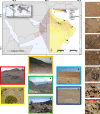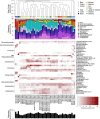Habitat-dependent composition of bacterial and fungal communities in biological soil crusts from Oman
- PMID: 31015576
- PMCID: PMC6478931
- DOI: 10.1038/s41598-019-42911-6
Habitat-dependent composition of bacterial and fungal communities in biological soil crusts from Oman
Abstract
Biological soil crusts (biocrusts) occur within drylands throughout the world, covering ~12% of the global terrestrial soil surface. Their occurrence in the deserts of the Arabian Peninsula has rarely been reported and their spatial distribution, diversity, and microbial composition remained largely unexplored. We investigated biocrusts at six different locations in the coastal and central deserts of Oman. The biocrust types were characterized, and the bacterial and fungal community compositions of biocrusts and uncrusted soils were analysed by amplicon sequencing. The results were interpreted based on the environmental parameters of the different sites. Whereas at lowland sites, mainly cyanobacteria-dominated biocrusts were observed, both cyanobacteria- and lichen-dominated biocrusts occurred at mountain sites. The majority of bacterial sequences (32-83% of total sequences) belonged to Actinobacteria, Cyanobacteria, Alphaproteobacteria, and Bacteroidetes, whereas fungal sequences belonged to Ascomycota, Basidiomycota, and Chytridiomycota (>95%). With biocrust development, a notable increase in cyanobacterial and decrease in actinobacterial proportions was observed for cyanobacteria-dominated crusts. In coastal areas, where salinity is high, biocrusts were replaced by a unique marine mat-like microbial community, dominated by halotolerant taxa. Redundancy analysis revealed a significant contribution of soil texture, cover type, carbon content, and elevation to the variations in bacterial and fungal communities. Multivariate analysis placed microbial communities in significantly separated clusters based on their carbon content, elevation and electrical conductivity. We conclude that Oman hosts a variety of cyanobacteria- and lichen-dominated crusts with their bacterial and fungal communities being largely dictated by soil properties and environmental parameters.
Conflict of interest statement
The authors declare no competing interests.
Figures






References
-
- Whitford, W. Ecology of desert systems (Academic Press, 2002).
-
- Garcia-Pichel, F. & Belnap, J. In Biological soil crusts: Structure, function, and management (eds Belnap, J. & Lange, O. L.) 193–201 (Springer Berlin Heidelberg, 2003).
-
- Elbert W, et al. Contribution of cryptogamic covers to the global cycles of carbon and nitrogen. Nature Geoscience. 2012;5:459–462. doi: 10.1038/ngeo1486. - DOI
-
- Rodriguez-Caballero E, et al. Dryland photoautotrophic soil surface communities endangered by global change. Nature Geoscience. 2018;11:185–189. doi: 10.1038/s41561-018-0072-1. - DOI
Publication types
MeSH terms
Substances
LinkOut - more resources
Full Text Sources
Medical

